
INTRO
In part one of this essay, we discussed goods labeled “tactical” and the apparent reference intended by those objects. Our conclusion was, roughly, that tactical objects allow wearers / users to perform an association (a perhaps defensible one) with the armed services and various first responder personnel: police forces, and so on.
We also uncovered a fundamental tension present in many tactical goods: try as they might to denote a particular lifestyle or occupation, these objects largely connote them. In surveying the array of tactics-based products, one may behold multitudinous visual metaphors for lifestyles focused on service and preparedness but may notice the lack of a material association with those lifestyles, or the people who practice them. In short, we came to understand aspects of tactics-things as pure fashion.
But the ‘authenticity’ of the objects is not under question here. Rather (or really: in result), we ask how a person may ~become~ “tactical” or “a tactician” through the purchase and use of these items. In this second and final installment of a Half Baked study concerning A Material Semiotics of Tacticality we’ll discuss what tactics are and how the tactical-as-such can be seen in tactical goods. We’ll discuss the ethics of the tactical system of objects, and that system’s seepage into various locales.
First – one admission, and two clarifications: I should have been more clear about my own, personal fascination with tactical items in Part 1. I have not partaken of tactical canned pig but do own–and, truthfully, usually have on my person–a tactical pen, and flashlight. I own pants, a backpack and jacket which one would be fair in identifying as tactics-inspired. I have never purchased anything from them, yet somehow I am on the 511Tactical.com mailing list.
My attraction to these things felt natural, so to speak–and so I could not resist subjecting both my attraction and the things themselves to criticism (in the sense of what “a critic” does: questions the seemingly given, or natural aspects of a thing or process, in order to uncover what about that thing’s nature is, in fact, contingent). That being said, while a personal interest began this inquiry, it was not long until aspects of tacticality and its associated goods–their design, significance, and apparent target [har har] market–implied the utility of a more careful and wide-ranging consideration. This brings us, now, to the clarifications.
First: insofar as any criticism is levied on the use, or significance of Tactical Stuffs, none of that criticism has been applied to the communities with which those Stuffs seek to associate. No charge has been levied against the people who would appear to inspire commercially available tactidoodads. It is not service members who are implicated here, but market forces, commercial entities, and a certain subset of consumers who have turned simulacra of those professions into salable items, thus allowing them to be donned as ornament, or reconfigured as seemingly self-aware comedic knick-knacks.
And second: we should confront the undiscussed close proximity in which “serious objects” like flashlights or multitools, and “joke objects”, like mugs, diaper bags and pens have been placed. There is an arguable level of irony in the latter, not present in the former. Is a disservice done by grouping these objects?
For context, we turn to Richard Hewitt, a retired Lt. Col. USAF Pilot and creator of the Nutnfancy Project, a YouTube channel which Hewitt claims originated the video gear review. He states that the focus of his channel, “since 2006 has been tactical and outdoor gear systems.” In a video titled “Debunking 10 Top Tactical Myths by Nutnfancy”, Hewitt acknowledges the tonal whiplash endemic to high stress, and particularly combat situations; “Cops know what I’m talking about […] Seals know what I’m talking about,” he says.
Hewitt describes situations where the tone shifts rapidly between dire and light-hearted. Those tasked with carrying out dangerous or violent and often life threatening tasks crack jokes to relieve stress; he explains how those that maintain a deadly serious demeanor don’t perform as well – the implication being that humor evacuates tension, thus allowing those practitioners to better, and more calmly, accomplish their mission.
I feel it is appropriate to place Tactical Baby Carriers, or Tactical Soap alongside Tactical Gunderwear and Flashlights with strobe settings meant to disorient your aggressors because they are two classes of object, yes, but they are united by their context – and both serve a function within it. While the tactical and the tacticomical may be sub-classes of thing, their supra-class is borne of a context concerning combat violence, and the unavoidable politics thereof. The grenade soap may be funny within that frame but remains–more generally–a serious object. We will discuss this at length in a few pages, but so it has been stated up front: a soap grenade is more ‘about’ grenades, than it is about soap.
ASIDE: Am I saying there are things which one may not joke about? I am not. I am judging the quality and effectiveness of those jokes. As I have said elsewhere, I believe that there is no subject matter about which one cannot joke, but that increasingly dark or painful topics require increasing skill to make humorous. As anyone who has ever been in a Spencer’s Gifts can confirm, objects are a particularly difficult medium with which to set up, and deliver, effective humor. It may exist, but if there’s an object which tells a successful joke about the professions conjured by The Tactical, I have yet to see it.
PART ONE
We are now prepared to discuss what tactics, as such, are. To further our understanding of the items we take as our focus, we ask first: what are “tactics” as such? And second: what does it mean for a person to be described as “tactical”?
Most often, we see tactics set against strategy. In broad terms, a strategy is one’s plan of action, with a particular aim in mind. Tactics are the actions themselves. A popular dichotomy holds that strategy happens above the neck, and tactics happen below. Sun Tzu, in The Art of War, wrote that “All men can see these tactics whereby I conquer, but what none can see is the strategy out of which victory is evolved.”
While one may have a strategy for darning socks, and enact that strategy with a particular set of tactics…. While one may have a social media strategy pursued through tactical media buys or tactical engagements…. While one may strategize the most efficient production workflows in Dwarf Fortress, and implement that strategy through workforce management tactics… in the realm we take as our focus “tactics“ and “being tactical” have specific meanings.
We now return to Nutnfancy / Richard Hewitt, who personally views the tactical as concerned with “emergency self defense”. He provides not much explanation, but seems to propose a level of preparedness, skill and kit such that one may ensure their own bodily sovereignty at a moment’s notice. Hewitt admits this is not how most people conceive of tacticality. Most people see the tactical as associated with “warfighters”, he says: well outfitted soldiers deployed to harsh environments, who possess the skill and materials to carry out dangerous, high-stress missions.
But Hewitt, and others in the online tactical community, seem to perceive a tension in the word as we have. Tacticality is an “idea“ and not an “object description”, I’ve seen it said. Anything can be tactical depending upon you use it, is a complaint regarding the word’s polysemy. “Tactical,“ in a YouTube comment, “as its used today, is the politically correct replacement for the word ‘combat’.”
This further corroborates conclusions from Part 1, but only answers to the ideal of what it means to be tactical. It gives further basis–the idea of action, the idea of the warfighter–for understanding what is desired in an involvement with the tactical. What we pursue now is an answer to the question of what it means to acquire Tacticianhood through the constellation of goods advertised, and sold as tactical. We are concerned with the system of meaning that emerges from these goods, and what outlooks, values and indeed what sorts of actions we may expect they enable. We are curious what strategy those actions serve. Such will be the focus of the next two sections, respectively.
To begin, we go seemingly far afield, and discuss Marxist philosopher, political historian and critic György Lukács.
PART TWO
Lukács was a Hungarian Marxist philosopher best known for the theory of reification. This concerns a process of psychological internalization engaged in by those living under capitalism: through reification, people become objectified (turned into objects; considered inert and powerless in the face of the political/historical/economic moment) and objects–markets, financial instruments–are subjectified (given a kind of agency; thought to behave independently from the people who manage them).
In his 1919 essay “Tactics and Ethics“ he writes about just that: political tactics, their associated ethics and how each is fundamentally different depending upon one’s political position and class. Mostly concerned with socialism, his ideal tactics and ethics are quite specific. But there are concepts of his which are useful to us nonetheless.
In Tactics and Ethics, Lukács discusses “tactics” as “a means by which politically active groups achieve their declared aims, as a link connecting ultimate objective with reality…” There are two sorts of politically active groups in his focus: those who seek to maintain the current order of things and those who would like to upset the status quo. Incumbent power and revolutionaries, both engaging in tactics as a means for realizing their political ends.
I want to make the case, starting with our baseline understanding of what a tactic-as-such is, then paired with Lukács’s thought, that Tactical Goods are in fact tactical, only not as advertised or not just. Don’t get me wrong: a tactical polo may give you the range of motion needed to karate chop someone coming for Scott Pruitt but its tactical features don’t stop there. The Tactical is tactical in that it is (as opposed to simply ”allows“) a set of actions. Those actions then further a political objective as Lukács suggests tactics do.
How so? If we continue to accept that the dark, knurled, ruggedness of tactical objects conjures combat forces, “warfighters” and the like, then those who don this gear create some association between themselves and those professions, specifically. They also create an association between themselves and state power, generally. The association may be intended or not and it may be justified or not but it is present nonetheless. As police, soldiers, SWAT team members, and so on give the tactical its significance through visual reference and are easily recognized agents of state power, we can see how one’s adoption of the tactical as fashion could lead to their association with the state and its related authorities.
This signification-by-steps hints at the action of The Tactical but is not the action itself. The action taken by The Tactical itself is the commodification of state power through a set of objects that conjure said power when worn. The tactical, as popularly understood and sold, makes commercial and available for consumption incumbent state authority.
The political aims furthered here–the facet which closes the loop on the Lukácsian reading of The Tactical as tactical–are quiet and complex. But we’ve confronted them in the course of our work. Insofar as we consider the political to concern the distribution of power–who is afforded what resources, including influence, notoriety and authority–visually associating oneself with law enforcement, soldiers, corrections officers, etc distributes to those groups additional iotas of power. To sport The Tactical is to engage, by degrees, in an aesthetic joining of the ranks so to speak, as much if not more than it is an indication one is capable of like… jumping over a fence or whatever.
The Tactical reifies and normalizes incumbent state authority. It helps to turn the object of the state into a subject; and it helps turn us, subjects of the state, into objects.
The Comically Tactical is especially effective at this normalization as it derives its impact from the boldness of that normalization’s assertion. The bacon, the socks, et al, insinuate state power into the banal to the degree of absurdity; it is from the absurd combination of elements that the “humor” of these objects arises. The grenade soap is “funny” because agents of the state use grenades to kill people or destroy property and you use soap to clean your body. LOL! To call this chimeric object “tactical” is accurate – not just because it has a meaningful association with groups of people who engage in “tactics”, but also (though I would argue primarily) because the object itself is a tactic.
”But“–you may say, finger pointing skyward–“surely the creators and wearers of pants with a double-reinforced crotch or a green, cleaning grenade are not necessarily supporting the aims of the state.” You may be right – first worth noting is that this is a continuum, not a binary: how much an object or objects help to conjure the presence of, or visually reference state power when possessed, worn or used by a person is how much those objects and that person normalize and reify that power. One may use visual signifiers in such a way as to undercut their significations, as well. We’ll discuss this more in the next section.
But also worth noting: the circumstantial, potentially accidental nature of any tactic does not free it from service to some strategy. By way of explanation we return briefly to Lukács.
He discusses how, in effect, choosing the right tactic for your overarching strategy is a political act–you are shifting power, notoriety, resources towards a plan of action. This constitutes an ethical decision: something which may be judged as right, or wrong, good or bad. Not choosing any tactic, not being aware of or active in your tactical choices is also a political, ethical decision. Not taking into account the context in which one operates, being not-knowledgable of one’s position… these are choices and they have as much ethical content as active decision making. Lukács writes:
…ethics relate to the individual and the necessary consequence of this relationship is that the individual’s conscience and sense of responsibility are confronted with the postulate that he must act as if on his action or inaction depended the changing of the world’s destiny, the approach of which is inevitably helped or hindered by the tactics he is about to adopt. (For in the realm of ethics there is no neutrality and no impartiality; even he who is unwilling to act must be able to account to this conscience for his inactivity.)
Every person can know the moral / ethical content of their deeds, Lukács points out. Of course that work is hard and often crushing, so the question is whether and where one attempts to know the ethical content of their deeds. It is possible if not easy to remain un-self-conscious in ones actions, not recognizing the politics of them. Lukács’s particular discussion of tactics focuses on class consciousness and the work socialists must do–knowing their political-historical position and class status–to bring about socialism. But being mindful of your actions and trying to square those actions with your values is plain old good advice, y’all. Especially the point concerning the unavoidably political content of inaction. These ideas are applicable to our purposes as well, and the donning of vests with lots of pockets and velcro and stuff.
Under what strategies may we see The Tactical as an ethical tactic? Here we must stress the significance of individuals. We must take into account the passive and the active. Towards this end we will engage in a brief consideration of some Tactical Characters. We will discuss how certain archetypes may be perceived as “Tacticians” and what strategies of theirs The Tactical may or may not serve.
PART THREE
The following three portraits do not represent the sole reflectors (or refractors) of The Tactical; they are simply the ones I feel provide a representative and interesting array. They are not meant to represent whole groups, but they are likely to evoke familiar “types”.
To begin: some background.
In particular corners of the armed services there are soldiers known as “Operators” – short for “Weapons Operator”. The Operator is a renown kind of position thought to designate a particularly flinty soldier. This solider has a look: vest / plate carrier, M16 rifle, dark sunglasses, often a bushy beard, and occasionally a keffiyeh.
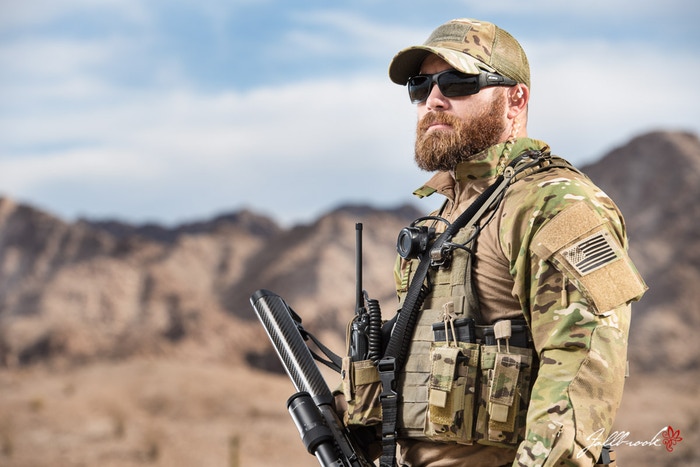
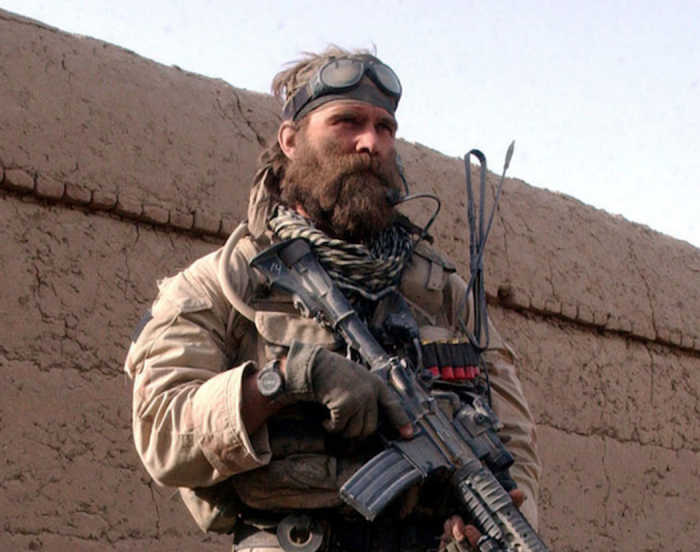
These gents are some of the “warfighters” Hewitt references. But over the last 8 to 10 years the “Operator” designation has been watered down. Like the tech industry’s use of “ninja” or “rock star” to reference people who are not, “operator” has come to mean its opposite, used with increasing sarcasm in the service itself[1]. The label has been variously overused and misunderstood as well as usurped – notably by what we might term Online Operators. This is an often half (???) serious group of folks who deal in Operator memes and other assorted combat ~content~ some of which is laudatory of, and some of which is critical of the tactically bedecked. Overzealous tactical practitioners (“tactitioners” felt like too much of a stretch) may be referred to, sarcastically, as “operator af”.
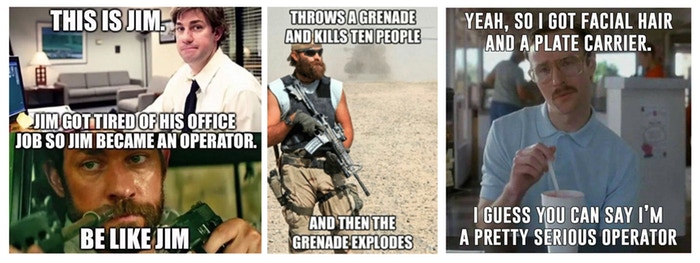
The term Operator shifted, also, on account of the rise of the “Mall Ninja”. This term once referred to the sort of gentleman who’d frequent the mall in a long dark coat and covet the katanas at Chesapeake Knife and Tool (RIP). But Mall Ninja came into wide use, and as a reference to firearms enthusiasts specifically, after the escapades of multi-forum user Gecko45.
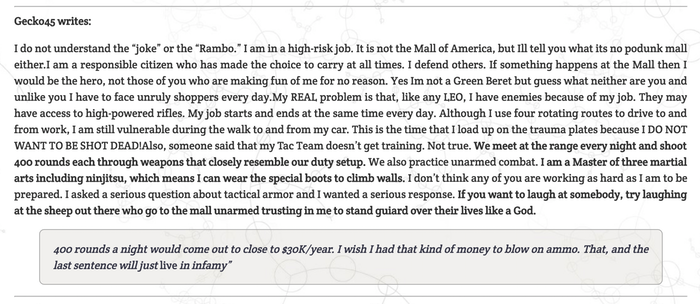
You may find the collected works of Mr. Gecko here, but the long and short is that a Mall Ninja is not an Operator, (though they may be operator af?). They are a caricature of person imagined as earnestly enamored of The Tactical, a firm believer in the tacticool.
Knowing not the strategies of every Gecko45-alike, it is tough to judge the Mall Ninja’s tactical use of The Tactical categorically. What aim do their Tactical tactics serve? We are left in the realm of speculation. Though we do find this realm familiar, we should nonetheless be aware of our context (as Lukács has suggested), and proceed with knowledge of our surroundings (as a good tactician might). *complex hand motion which I’m pretty sure means ‘let us proceed’*
We will speculate that Mall Ninjas et al think that state agents, and those who defend the sovereignty of the state (or “a state” – in the case of a separatist bent) with violence, are dope as hell. It does not stretch imagination to think that those buying tactical polos and batons support state power, and whatever tactics are deemed necessary for its continuance. Maybe they think grenades are rad and wanna rub one on their body and that’s the beginning-and-end of it but it is possible their tactical accessories are an implicit vote of support for the state, and/or the agents who maintain its authority, and/or the armaments associated with those agents.
In situations where our speculation is correct, the adoption of the tactical aligns squarely with these strategies. As discussed, to don the tactical is to, by degrees, associate oneself with and to normalize the presence of state agents. The tactically infatuated may find the tactical toothbrush compelling because they have positive associations with “warfighters”, and would like to advertise and, in more than one sense “own”, that association in as many aspects of their life as possible, including while polishing their chompers. Checking their conscience for the appropriateness of their actions, they may find congruence with the commodification of the personnel, and tools related to state power, and a willingness to normalize and reify that power.
ASIDE: If you’ll allow me another bout of pure speculation, this is perhaps one reason some with a first hand experience of combat may be impatient with those who overindulge in The Tactical. After direct involvement with state power, I imagine some service members may not be so rushed to invite it into ever more far flung aspects of their life (their socks, e.g.) but they nonetheless recognize the contextually dependent utility of various accessories / build qualities / knurling patterns.
Where tactics and strategies diverge is where a desire to Tacticalize runs into a hesitance regarding state authority, and its presence in ever more remote facets of life… like say one’s use of empathy. I find this tension present in the EDC or “Everyday Carry” community. A group of roughly dissimilar individuals concerned with everyday preparedness (as opposed to the “preppers” brand of disaster preparedness), the EDC cohort is notable for members’ detailed consideration of items carried on their person, often worn or simply pocketed: a knife, a flashlight, a pen, and a watch; occasionally a lighter, a bottle opener, a multitool, a multi-use bracelet or belt, a notebook…
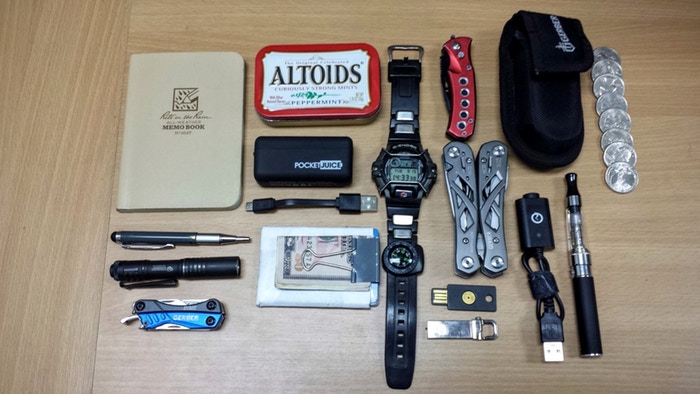
Objects of the EDC mold are usually rugged, frequently black, and often have been considered for their weight, and usability. EDC objects are sometimes knurled. They are often knolled. As you may imagine, the line between the Tactical and the EDC-able is sometimes sharp, sometimes blurry. But each group feels similarly caught in the gravitational pull of the Vaguely Military.
I often wonder to what degree Everyday Carriers flaunt this association. Do they intend it? Skate it? Leave it unconsidered? I ask this as someone with EDC tendencies: to what degree do my pen, flashlight, boots, and pants “cut for movement and made from the most ruggedly comfortable tech fabric around” coalesce into a blurry portrait of a state agent? Lukács warned of associations with existing authority, especially if one intends to work against it and build a more equitable future. “Every gesture of solidarity with the existing order,” he wrote, “is fraught with such danger.” Does my own tacticality hinder, or become unethical given, my own political strategies?
I leave the question open, as this is not the time for self introspection. But I do offer an apologia-by-proxy. Sci-fi author and well known appreciator of military fashions William Gibson has said that it is not the military-ness of those fashions which attracts him. “It’s not about macho, playing soldiers, anything militaristic,” he said to David Shuck for Heddels. “It’s the functionality, the design-solutions, the durability. Likewise workwear.” If the garments were to lose all military association and retain their quality they would be just as suitable. ”’Authenticity’ doesn’t mean much to me,” he says. “I just want ’good’, in the sense of well-designed, well-constructed, long-lasting garments.” One may wonder if the military connotations are as immaterial to others as they are to Gibson; my hunch is that EDC allows people (men, mostly) to accessorize in ways they do not otherwise feel permitted. That permission is given by, and not in spite of, those objects’ military connotations. Put another way: I rarely need my tactical flashlight; I do think it looks cool and tough in my jacket pocket. But enough about me. ✌️
Our final Tactically Adjacent set is a fashion culture made known by brands like Outlier (previously referenced), ACRONYM, Arcteryx and others. It is a style known as “Techwear”.
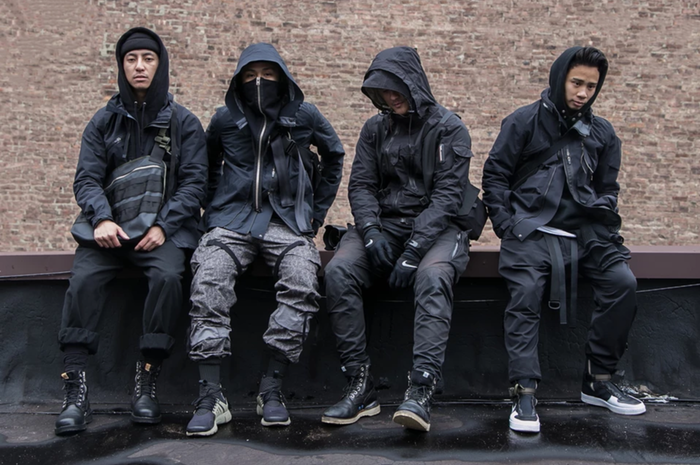
Rocky Li for Grailed describes techwear as “clothing for everyday life with special fabric, construction and properties that allow for breathability, movement, water-resistance and comfort.” This clothing is often black, and replete with pockets. Jordan Farris on Dam Chic writes techwear items “should be as functional as they are fashionable.” Save for the emphasis on being fashionable (?buuuurrrrrnnnnnn?), these characteristics should ring relatively, tactically familiar.
In a long, detailed reddit post about the “difficulties, advantages, stylings, and attitudes” of techwear, user Haolopteryx describes Techwear as ”the internet’s favourite alternative fashion trend”, explaining the style is “vaguely avant-garde but hits a pre-existing sense of ‘cool’”. That avant-garde coolness derives from the style’s futuristic design. Techwear is made from ~space age fabrics~ and ultrastrong, ultralite composite materials. Pieces feature retroreflective panels, straps and buckles for days. Pieces interface with wearers various devices. The advertisements feature severe people (men, mostly) in urban environments, darkly lit alleyways and nondescript grey planes.
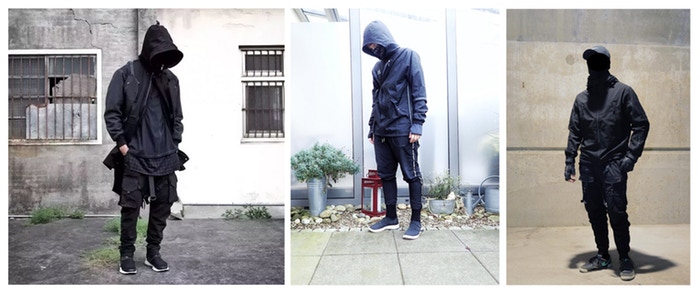
Like The Tactical, these clothes are suitable for varied environments; their wearers are prepared, and this clothing can be used. But for what, precisely? These items don’t have the same immediacy as, say, a flashlight or pair of waterproof boots. Their avant-garde nature obscures and even occasionally confounds their usefulness. To find it, we must briefly delve the ideas which inspire these clothes.
Errolson Hugh, founder of ACRONYM has said that the label was partially born out of the idea that everyone is a cyborg: “You don’t have to graft a device onto your skeletal system to be a cyborg“ he explained to High Snobiety. This clothing is an augmentation: extrapolating to a future where garments themselves may be considered devices. Importantly, and through this, we see Teachwear’s multifaceted relationship to the Cyberpunk genre restated often, in both style reference and critical reception. For Grailed, Leslie Zhang writes “Techno-orientalism helped birth speculative fiction and cyberpunk, which have undeniably influenced techwear’s development.”
Cyberpunk stories often question what is and is not “human” by positing largely cultural/semantic distinctions between the technological and the biological. As technology becomes increasingly incorporated with the human body (in-corpus-erated?) one of the last frontiers before full embodiment is the material closest to the skin. A device-like garment is both a step towards and a believably common occurrence in an imagined future where the corporeal saturation of technology is complete.
There is also a militaristic twinge to Techwear – echoed in the buckles and straps, the pockets and the compartments, the materials and their qualities. This is clothing for use and preparedness. But like most Tactical Items, while that preparedness masquerades as general it is in fact highly specific. Techwear and The Tactical do not seemingly prepare one to bake a cake, balance a checkbook, or refinish a countertop. They prepare one to engage in a hostile environment, often with the suggestion that said environment contains aggressors (recalling here Hewitt’s definition of the tactical as being about “emergency self defense”). Who are we to imagine the cyberpunk / techwearer defends against?
The protagonists of Cyberpunk stories often face off against various corporate-state authorities – police forces and military outfits paid for by corporate entities whose interests, and property, those forces protect. But these characters also often hide, or sneak, knowing the individual would not fair well in a direct confrontation with those authorities. Pervasive surveillance means they must, also, do this sneaking plain sight. William Gibson–an initiator of the genre–speaks of the Grey Man: a covert agent who blends in to their surroundings, but whose garments are of a speciality build. Their clothes offer no visual clues about their status or skill but their construction is suited, if not designed specifically, for their specialized work. Think James Bond, perhaps. Or The Kingsmen. But also Techwear.
Here we can begin to answer our question: What is techwear “for”, if it is inspired by – but not the same as – The Tactical? The militaristic twinges of Techwear are opportunistic, if not sarcastic. It borrows visual signifiers of the state’s imagined future agents–futuromilitaristic, if you will–but these clothes are conceivably worn by those imagined to challenge that state. They allow the wearer to blend into a future which has yet to arrive: one of pervasive technology, and pervasive state violence in service of increasingly corporatized interests. There is no hiding, but that does not mean there is no secrecy and no preparedness.
Another view posits that this future has already arrived.
Insofar as a Techwearer’s attraction to the style is through cyberpunk, we may appreciate parallel strategies: warning of, or announcing, the dystopia. If one’s practical criterion for action involves concern over an impending, or already arrived, corporate-political technological hellscape then Techwear as tactic could be seen to align with one’s strategies, even–or really, especially–if it borrows from a pro-state power style that seems, politically, its opposite. They are the predictive commodification of state power, and it’s distribution to ostensible revolutionaries.
As in our previous segments of this study, how much any given Techwearer intends or even perceives these connotations is left to question – what authority do they mean it conjure, if any, and what other facets factor into the perception of that authority by others? As with the tactical, the tacticool, and the EDCable – the question is one of degrees and inflections, of context and surrounding… not one of binary representations. The beauty of fashion is that it’s endless permutations allow for a subtlety impossible to capture in its entirety in a consideration of this scope, if at all.
The mutual constitution of object and person through their interaction is a complex business, and one not especially suited for the confidence of certainty, or blanket claims of truth. Each item worn by a person, and every garment in which we find meaning could be viewed through the lens we’ve used here: as a tactic in service of some strategy. Anything can be tactical depending upon you use it, they said. How right they were! but simply unaware of the breadth of their claim.
But here we have taken on The Tactical, as tactic. Spurred by perhaps not much more than personal interest, and the novelty of the association. I hope, in any regard, this Half Baked study has been entertaining, if it has not been enlightening. I hope we have shown a knurled, and waterproofed LED light on a few methods for the consideration of The Tactical, its tactics, and their impact. Until next time: stay frosty, chummers. Rugnetta out.
— NOTES —
[1] See https://twitter.com/JoshuaTMangan/status/1011369753275924481, as well as https://twitter.com/JamesMcAlear/status/1011363847641468935